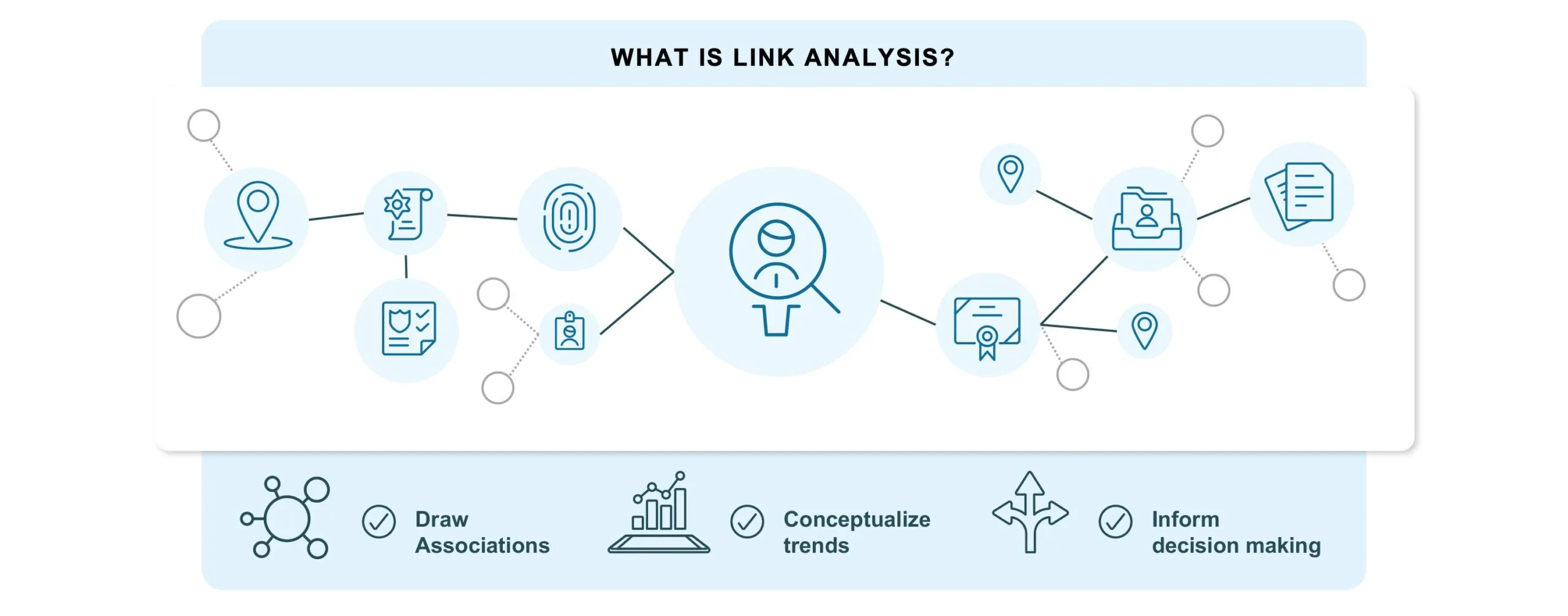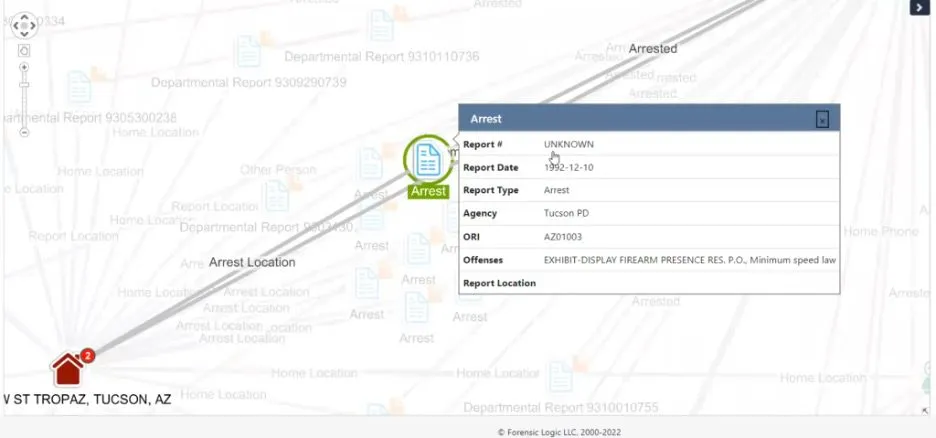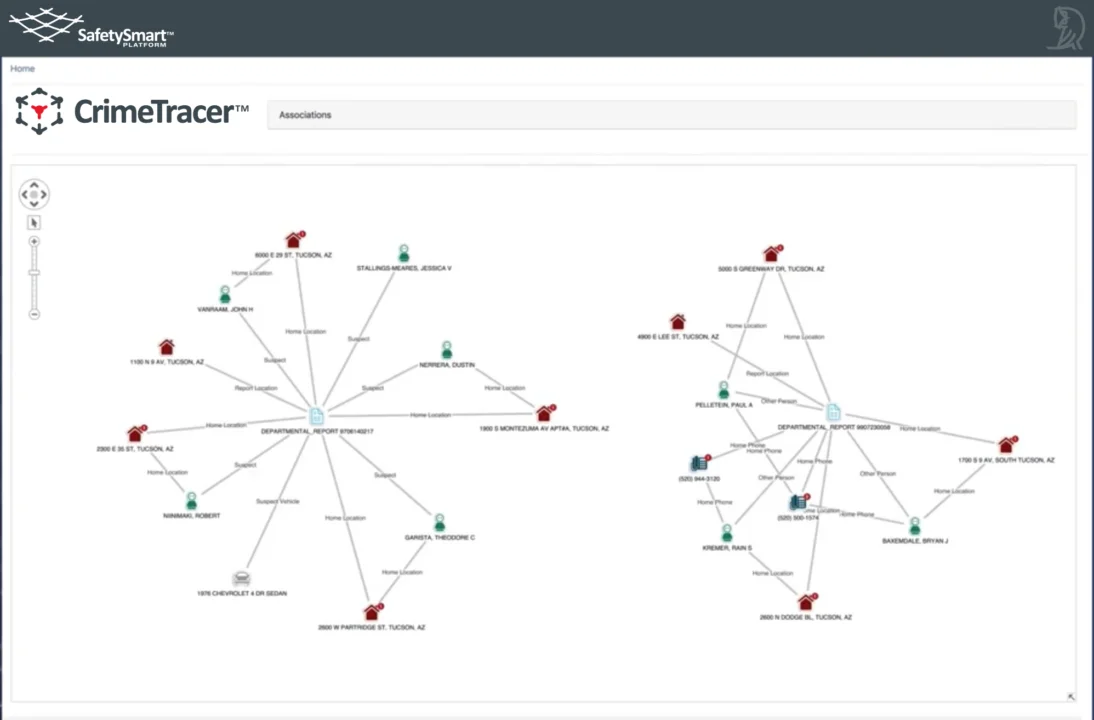In the policing domain, these data points are usually people, locations, vehicles, property, organizations, and firearms. When visualizing this information, each individual entity becomes a “node” on the chart tied to other nodes by way of their relationships or “links” to each other. By leveraging link analysis, investigators are better able to establish meaningful relationships between people, locations, property, and bank accounts, and oftentimes expedite cases in the process.
We’ve all seen law enforcement TV shows where the detectives have a big board behind them with strings and photos attached to it. In a nutshell, that’s what link analysis is. It’s a quick way to see people, places, strings, and things.

Current Challenges with Link Analysis
Most systems only aggregate data and display link charts of that aggregation. This limits the use of link charts to only displaying how entities are related within a single document. CrimeTracer™ is different in that it consolidates data from across the country, providing a comprehensive set of relationships between entities that extend across jurisdictions.
Furthermore, while other systems can aggregate documents from various agencies across the country into a single repository, they do not consolidate the entities (people, places, things) into unified records that can be investigated from a single point of reference. So, an investigator will still have to read all the individual reports to find the associated people, vehicles, locations, and more that are needed to build a case.
Ultimately, the problem facing analysts and detectives currently is that there is no figurative “board” that is big enough to connect all the “strings” in any meaningful way. Too many “strings” on the board obscure what is pertinent and what is irrelevant. Ultimately, link analysis solves this problem.
How CrimeTracer Differentiates Itself in the World of Link Analysis
CrimeTracer is a powerful law enforcement search engine and information platform that enables law enforcement to search over 1.3 billion records from agencies across the U.S.
Furthermore, CrimeTracer recognizes that valuable data is not just limited to arrests or bookings or incident reports: relevant data can be found in sources as disparate as court records, LPR, ShotSpotter incidents, pawn tickets, and jail records. CrimeTracer’s ability to consolidate data from over 40 different document types provides the most robust searchable database for subjects of interest available today.

For example, let’s say a search on a license plate of a suspect in Phoenix brought up several parking tickets outside a residence in Los Angeles. Each of those data points becomes a separate node that links to one another and shows a correlation between all three. From there, each new entity becomes a point that can be expanded and quickly an association list can be developed and ranked in order of importance depending on how many associations each node has with one another.
Whether by providing a heat map ranking closest associates and their relation to the subject, depicting the evolution of behavioral patterns over a timeline in question, or linking perpetrators and their probable relation with suspected gang affiliates, CrimeTracer provides powerful and valuable tools for aiding investigators.
CrimeTracer Link Analysis Features
Visualizer – CrimeTracer’s visualizer is a powerful tool that allows investigators to explore relationships between entities in a universe of over 1 billion documents. The visualizer’s toolbar provides the ability to search within the chart, observe how networks evolve over time, filter by entity, and apply social network analysis algorithms.

Refined Search – CrimeTracer also enables investigators to build patterns and establish in-depth connections between entities. For example, let’s say you have a suspect in custody and you want to find known associates using specific indicators such as age, sex, race, or identifiable markings, the platform provides the ability to do just that.
Additionally, CrimeTracer draws from all known case files, incident reports, and records to find that information and then sorts it based on how many times each entity is mentioned. Suddenly a person who was just a single node entry on a graph at the beginning of an investigation has their entire web of influence mapped out. The “strings” are now depicted in an easy-to-read fashion, making it easier to expedite investigations.
Conclusion
Link analysis will always be an integral part of the investigative process, but valuable data isn’t just about arrests or bookings, or incident reports, it’s about identifying and understanding how the different pieces of a puzzle relate to each other. A law enforcement search engine and information platform like CrimeTracer can help investigative teams do just that.





